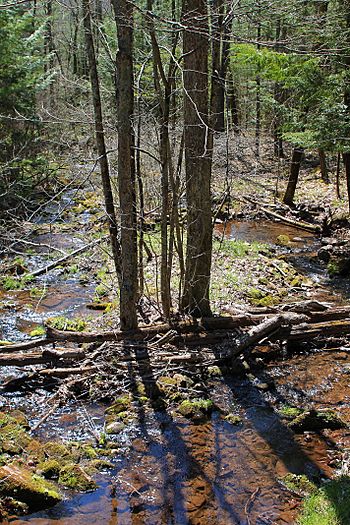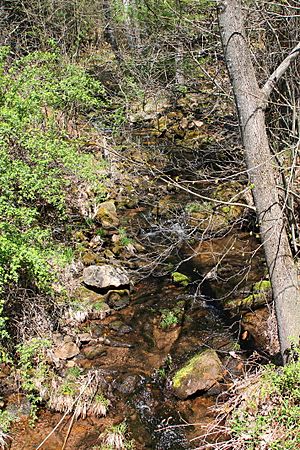Lick Run (White Deer Creek tributary) facts for kids
Quick facts for kids Lick Run |
|
|---|---|

Lick Run looking downstream
|
|
| Physical characteristics | |
| Main source | South White Deer Ridge in White Deer Township, Union County, Pennsylvania 1,762 ft (537 m) |
| River mouth | White Deer Creek in White Deer Township, Union County, Pennsylvania near White Deer 938 ft (286 m) 41°03′54″N 77°02′52″W / 41.06494°N 77.04780°W |
| Length | 2.7 mi (4.3 km) |
| Basin features | |
| Progression | White Deer Creek → West Branch Susquehanna River → Susquehanna River → Chesapeake Bay |
| Basin size | 2.10 sq mi (5.4 km2) |
| Tributaries |
|
Lick Run is a small stream, also called a tributary, that flows into White Deer Creek. It's located in Union County and Lycoming County, in Pennsylvania, USA. This stream is about 2.7 miles (4.3 km) long. It passes through White Deer Township and Washington Township. The area of land that drains into Lick Run, called its watershed, is about 2.10 square miles (5.4 km2). Lick Run has one smaller stream flowing into it that doesn't have a name. Wild trout fish live and have babies here. Also, beavers once started building a dam on the stream.
Contents
Where Does Lick Run Flow?
Lick Run starts on a place called South White Deer Ridge. This is in White Deer Township, Union County. It flows towards the west-northwest through a wide, deep valley. After a short distance, it enters Washington Township, Lycoming County.
Here, the stream turns to flow west-southwest. Its valley gets deeper and narrower. Then, it turns south for more than a mile. It goes back into White Deer Township, Union County. Along the way, it gets water from an unnamed stream on its left side. It also flows past Little Mountain.
Lick Run then crosses over Interstate 80. It keeps flowing south for a short distance. Finally, it turns southeast and meets up with White Deer Creek. Lick Run joins White Deer Creek about 10.77 miles (17.33 km) before White Deer Creek reaches its own end.
Geography and Land Around Lick Run
The land around Lick Run has different heights. Where Lick Run meets White Deer Creek, the elevation is about 938 feet (286 m) above sea level. This is like how high a mountain is, but measured from the ocean's surface.
Where Lick Run begins, its source, the elevation is much higher. It's about 1,762 feet (537 m) above sea level. This shows how the stream flows downhill from its start to its end.
The Lick Run Watershed
A watershed is an area of land where all the water drains into a single stream, river, or lake. The watershed for Lick Run covers an area of about 2.10 square miles (5.4 km2). This means all the rain and snow that falls in this area eventually flows into Lick Run.
Lick Run is completely within a map area called the Williamsport SE quadrangle. This is a specific section on maps made by the United States Geological Survey. The place where Lick Run joins White Deer Creek is close to a town called White Deer. A part of the Lick Run watershed, about 0.89 square miles (2.3 km2), is located in Union County.
History of Lick Run
Lick Run was officially added to the Geographic Names Information System on August 2, 1979. This system keeps track of names for places in the United States. Its special ID number in this system is 1179299.
A railroad called the White Deer Valley Railroad used to run near Lick Run. This railroad was started on December 11, 1900. It was built in 1901 by John Duncan to help move logs. Later, it was sold to the White Deer Lumber Company. On April 17, 1906, it became known as the White Deer and Loganton Railroad.
In the early 1900s, people found the remains of an old log cabin. It was near where Lick Run begins, on a road leading to a place called the "Lost Valley."
Wildlife and Biology
Lick Run is home to wild trout fish. These trout naturally reproduce in the stream. They live and have their babies all along Lick Run, from its start to where it meets White Deer Creek.
In 1913, beavers started building a dam on the stream. Beavers are known for building dams to create ponds. However, one of the beavers was killed by a fisherman. After that, the other beaver left the area, and the dam was not finished.


